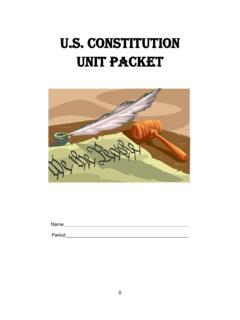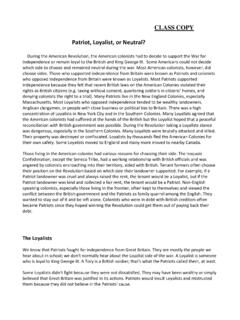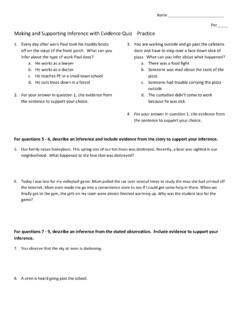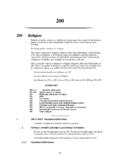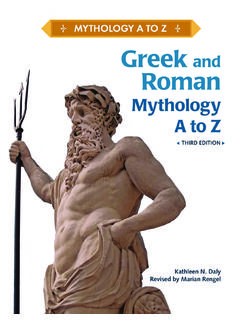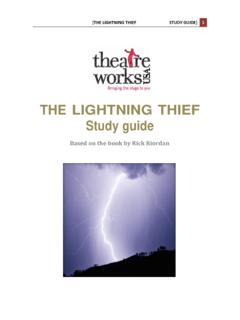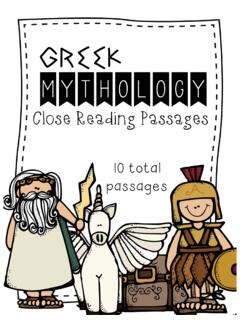Transcription of The Iliad, The Odyssey,
1 The Iliad, The Odyssey, andThe AeneidNEWYORK TORONTO LONDON AUCKLAND SYDNEYMEXICO CITY NEW DELHI HONG KONG BUENOS AIRESby Gwen BowerS Read-Aloud Plays: The Iliad, The Odyssey, and The Aeneid Gwen Bowers, Published by Scholastic Teaching ResourcesTo my dad for always expecting my best,and to the St. Charles class of 2005 for bringing these characters to life,and to Bernard and Dorothy Evslin and Ned Hoopes for breathing life into my childhood with their inspired stories of heroes and would like to thank Shanna Streich and Jenn Durrant for their advice, support, and friend-ship. I would also like to thank my editor, Sarah Longhi, and everyone who had a hand inmaking this book, for their faith and encouragement. Thanks to Lucy Hughes for help at theBritish Museum Library Reading Room. Thanks and gratitude to Professor BarbaraMacLachlan for her scholarship and classes in ancient epic.
2 And a super-special thanks toRenato, Patrick W., Alex, Adam, Patrick D., Richard G., Peter, Mikey, and Derrick (my firstAchilles) for their unbounded enthusiasm for the ancient world!Scholastic Inc. grants teachers permission to photocopy the reproducible pages from this book for class-room use. No other part of this publication may be reproduced in whole or in part, or stored in aretrieval system, or transmitted in any form or by any means, electronic, mechanical, photocopying,recording, or otherwise, without permission of the publisher. For information regarding permission, writeto Permissions Department, Scholastic Inc., 557 Broadway, New York, NY design by Jason RobinsonInterior design by Melinda BelterCover Illustrations by Jeff CarinoInterior illustrations by George UlrichISBN-13 978-0439-62918-8 ISBN-10 0-439-62918-7 Copyright 2006 by Gwen Bowers. All rights reserved.
3 Printed in the 2 3 4 5 6 7 8 9 104013 12 11 10 09 08 07 Read-Aloud Plays: The Iliad, The Odyssey, and The Aeneid Gwen Bowers, Published by Scholastic Teaching ResourcesIntroductionIs It Possible to Teach Classical Literature to Middle School Students? Yes! .. 4If You Choose to Produce the Plays: Some Don t Sweat It Basics .. 6 Activities for Building BackgroundPronunciation Is a Key to Success .. 8 Introducing Greek and Roman Gods and Goddesses .. 10 Fascinating Facts .. 13 Activities for Extending LearningMap Adventure Through Ancient Lands .. 14 Using Art to Convey Meaning: Greek Vases .. 19 The PlaysAn Introduction toThe Iliad.. 22 The Iliad (a read-aloud play) .. 25 Story Summary 1 .. 33 Story Summary 2 .. 35 Themes for Reflection .. 37 Test .. 38An Introduction toThe Odyssey..39 The Odyssey (a read-aloud play)..41 Story Summary 1 .. 56 Story Summary 2.
4 58 Themes for Reflection .. 60 Test .. 61An Introduction toThe Aeneid..62 The Aeneid(a read-aloud play) ..64 StorySummary 1 .. 74 Story Summary 2 .. 76 Themes for Reflection .. 78 Test .. 79 Answer Key .. 80 Resources .. 81 CONTENTSRead-Aloud Plays: The Iliad, The Odyssey, and The Aeneid Gwen Bowers, Published by Scholastic Teaching ResourcesIs It Possible to Teach Classical Literature to Middle School Students? YES! There is no better time to address universal issueslike friendship, suffering, and betrayal than in thepreteen and teen years, and there are no better exam-ples to use than these incredible stories The Iliad, The Odyssey, and The Aeneid which worktheir way into so many aspects of our culture your class to discuss Aeneas s position as animmigrant displaced by war, and see if students canmake the connection to current events. Let that student who can t sit still choose his favorite part toread.
5 And watch him take on the role of a greathero orpetulant Olympian. I have written these classics-inspired plays andactivities for my own middle school readers, whoneed highly motivating material to learn newinformation and to build reading skills. Each year,these plays captivate all types of learners from themost challenging to the most conscientious and self-motivated. Students gain insights into the cul-ture of ancient Greeks and Romans, and theybecome invested in the characters who drive theaction in these famous stories. At the same time, thedialogue format helps them use expression andphrasing, and repeated rehearsals build fluency resource provides you with everything youneed to teach the classic stories in an exciting andfun-filled way: nshort, engaging plays that represent theentire plot of each classic story nbackground and history that describe the talenactivities that help you teach the content andassess students learningAbout the PlaysHow do the three epic tales retold in these playsrelate to each other?
6 The Iliad, astory about the bitter war between the Greeks and Trojans over thecapture of the Spartan queen Helen by Trojan prince Paris, is a prequel toThe Odyssey and Odysseytells of the Greek warriorOdysseus s adventurous journey home after theTrojan War. The Aeneid is the story of the refugeeTrojan prince Aeneas and his long journey to find a new homeland. Studying these classics together helps studentsto better understand relationships among a family ofcharacters and deities that were at the cultural heartof the ancient Greco-Roman world. Yet, it s alsoimportant to recognize and point out to studentsthat The Iliadand The Odysseyhave a very differenthistorical and cultural context than The blind Greek poet, Homer, is thought to havecommitted to memory the first two epic poems inthe mid-800s Recent linguistic research suggeststhat the rhythm and rhyme of the poems and therepetition of character epithets assisted Homer andthose who came afterward in recalling the story foraudiences.
7 A standard text of both The Iliadand The Odysseywas written down by scholars at theGreat Library at Alexandria in about 600 , which means the tale, having been retold manytimes over, likely changed quite a bit from Homer soriginal Plays: The Iliad, The Odyssey, and The Aeneid Gwen Bowers, Published by Scholastic Teaching ResourcesThe Aeneidhas a more certain stamp ofauthenticity. It was conceived in the form of a writ-ten document by Virgil, a well-educated writer infirst-century Rome, who counted among hisfriends some of the most famous Roman citizens ofhis time, including the Emperor Augustus. Virgilpromised the emperor he would write an epic poemthat traced Augustus s Roman lineage back to theancient heroes and gods of the past an epic tomatch The Iliadin stature and to establish Romanroots in the classical tradition. Though Virgil diedbefore he had completed The Aeneid, his work wasquickly published and immortalized by the to Use This BookThis book offers a creative way for teachers of litera-ture, history, and drama to introduce students to thebest tales from the ancient world.
8 While a detailedtreatment of classical literature lies outside the scopeof this book, these plays and companion activities aredesigned to build essential background and improvestudents comprehension and to motivate studentsto want to learn more about these ancient cultures. In the first section of the book, you ll find a setofactivities to build students background knowledgeand extend their learning about the classics. Follow-ing these activities are three plays adaptations of theepics written for middle school readers with com-panion activities. Each play section includes a script,stories from mythology related to the epic story, amap activity, fill-in-the-blank summaries, themes forwriting or discussion, and a test. You may want towork through the three plays and their activities inorder since the stories build upon one another, oryou may want to pick and choose materials to fityour schedule and curricular needs.
9 At the end ofthe book you ll find additional resources for teachingthe classics and answers to the activity pages. Here are some ways to build backgroundbefore you begin teaching with these plays:sSTOCK YOUR CLASS LIBRARY WITH ANYRELATED RESOURCES ON THE ANCIENT students time in class to browse through thebooks. Make sure to have available a copy of each ofthe classics translated in verse or prose form so thatstudents can compare these texts to the plays theyare reading. Take the opportunity to set the stage fora scene by reading aloud a vibrant, thrilling passagefrom the unabridged text. This connects studentsmore closely to the format and style of the originalepic and helps them fill in details and become moreinvested in the story. For recommended translationsof the epics, see Resources, page ALOUD TO YOUR CLASSEXTRATALESWORTHTHEIRWEIGHT INTROJANGOLD,shorttakes on classic stories associated with the charactersand events of a play.
10 You ll find these tales in theintroduction to each play. The letter marked next tothe story in the introduction appears beside therelated scene in the play. You might read all the talesprior to reading the play and revisit them duringyour read-through, or share each story when youand your students reach the part of the play thatbuilds on the TO STUDENTS THAT THEY WILLALWAYS ENCOUNTER VARIATIONS IN EACH TELLINGOF THE EPIC THEY demonstrate how vari-ations occur in stories told in the oral tradition, suchas The Iliadand The Odyssey, whisper a sentence in astudent s ear and have him or her pass the messagealong so that each student whispers the message inanother student s ear. When the message has beenpassed around the classroom, ask the last studentwho heard the message to write it on the the first message on the board and marvel atthe difference between the two versions.




